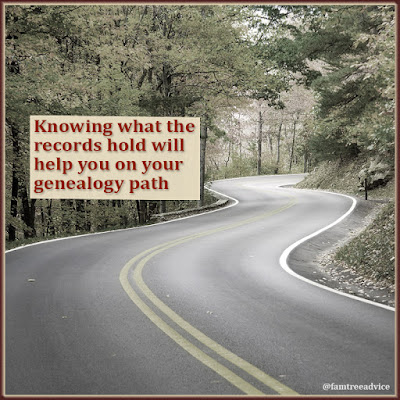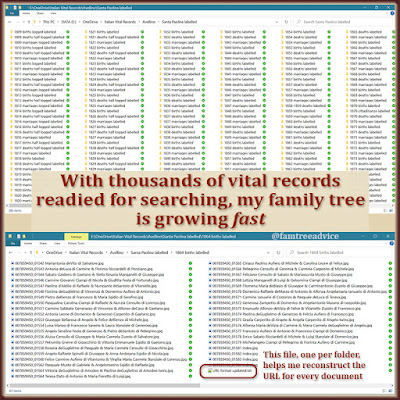In a whirlwind of research, I solved the mysteries of my client's great grandparents. I want to share the process with you so it can help you in your genealogy research.
The puzzle I had to solve was this:
- Where were Giuseppe Ruggiero and Giovannina Grasso born?
- How is it possible that they married in Italy after they arrived in America?
What We Knew from Documents
My client found naturalization and death records on Ancestry.com. From these documents we learned:
- Giuseppe was born on 3 Feb 1872 in Ricci, Italy.
- His parents were Frank Ruggiero and Veneranda Lucarsio.
- Giovannina was born on 24 Jun 1879 in Ricca, Italy.
- They both arrived in the United States on 22 Jan 1895 aboard the Olympia.
- They married in Ricci, Italy, on 14 Nov 1895.
Her family believes the couple was born in Riccia, Campobasso, Italy. And they've heard that Giovannina's parents were Luigi Grasso and Filomena Ponti.
Finding the Birth Records
To my surprise, no Ruggiero or Grasso babies were born in 1872 or 1879 in Riccia. I combed the surrounding years for any babies with the expected parents' names. In all, I found 13 babies.
Sorting through the birth records, I found only one Giuseppe Ruggiero. He was born on 3 Feb (as his naturalization papers say), but in 1868, not 1872.
I had a 12 Sep 1877 birth record for a Maria Giovanna Grasso. The name was fine since Giovannina was likely to be a nickname. But how could her birth day, month, and year all be so far from what the naturalization papers say? We'll never know the answer to that question.
 |
| Understand which information is on each type of genealogy document. Then follow the facts logically to solve your family tree puzzle. |
Which Came First: Marriage or Immigration?
How was it possible that the couple arrived on 22 January 1895, but married in Italy later that year? I knew I needed to see that ship manifest for myself.
On Ancestry.com, you can search for a New York passenger list by date and ship name. I went to 1895, January, 22 to see if the Olympia arrived on that date. It did not. I checked each date a week before and after the 22nd. No Olympia!
Had they made a mistake? I searched 1896 instead. On the 24th of January, I found the Olympia. The first people on the first page of the manifest are Giuseppe and Giovannina, husband and wife. That solves that mystery! They married in Italy in 1895 and came to America in 1896.
Since the couple arrived in New York in 1896, their ship manifest does not state their hometown. If they had arrived in 1898, as my family did, we would have known right away they came from Riccia.
I noticed their ages in 1896 did not agree with the naturalization papers. These stated ages helped me positively identify their birth records.
Luckily, the town of Riccia has its 1895 marriage records available. I found Giuseppe and Maria Giovanna's marriage, confirming their ages and their parents' names.
How Can We Go Back a Generation?
On the 13 births records I found, the parents' ages bounced all over the place. They were unreliable. I could take a stab at finding Giuseppe and Giovannina's parents' births in the indexes. But some of the years have no index.
I had to search for their marriages. But how would I know when either couple married? Italian couples of this time often had their first child within two years of their marriage. I needed to identify each couple's first child.
I searched year by year until their were no more babies born to either couple. When the well ran dry, I knew I'd found each couple's first child.
Giovannina's parents, Luigi Grasso and Filomena Ponte, had their first child in 1861. I found their marriage in 1857. Now I knew Luigi and Filomena's birth dates and their parents' names. Since both their fathers were dead by 1857, I learned their death dates, and their parents' names. Luckily for me, the bride and groom's paternal grandfathers were also dead by 1857. The 1857 marriage records included both grandfathers' death records with their parents' names!
I was not as lucky with Giuseppe Ruggiero's parents. Their first child was born in 1855, but I did not find their marriage in the years before that.
 |
| Knowing where to look to solve your genealogy mysteries will move you down that road to the solution. |
Knowing the Marriage Rules
I've been up to my eyeballs in Italian vital records since 2006. I know that a bride and groom from different towns had to post their intention to marry in both towns.
These postings are the equivalent of today's "If anyone knows of any reason why these two should not be lawfully married, let them speak now or forever hold their peace."
I couldn't find a marriage record for "Frank Ruggiero and Veneranda Lucarsio" in Riccia. And I didn't see anyone else in Riccia named Lucarsi (the proper spelling). My conclusion: Veneranda was from another town. But where?
I started in 1854 in Riccia, a year before their first child was born. I searched the "matrimoni pubblicazioni". These are the two public notifications of a couple's intention to marry.
I found them! I learned Francesco's age and parents' names, and Veneranda's age and parents' names. The documents didn't say where Veneranda was born, but they said her deceased parents had lived in "S. Croce".
It looked like a scribble, and I overlooked the town name at first. Then I realized what I had in front of me.
Looking at Google Maps, I found three possible Santa Croce towns in the area. But two were in the next province. I stuck to Campobasso and searched the 1854 marriage records in Santa Croce di Magliano.
Success! The town is missing the birth and death records usually associated with a marriage. That was a quick dead end. But I did learn something useful. Veneranda, whose age changed randomly over the years, was born in Santa Croce di Magliano in 1830. And I found her birth record.
What Next?
There's definitely more we can find. We could search Riccia for Francesco Ruggiero's siblings' births, and parents' marriage. We could search Santa Croce for Veneranda's parents' deaths and her siblings' births.
For now, it's great to sort out the inconsistencies and uncertainties in this family tree.
This can happen to you, too. When you know what the records contain, you can use them to solve your own genealogy puzzles.






